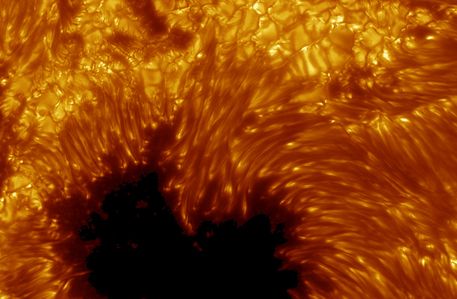The Sharpest View of the Sun
Fascinating Sunspots
 © SST, Royal Swedish Academy of Sciences |
This picture was made using the Swedish Solar Telescope in its first year of operation (2002) on the Canary Island of La Palma.
The filaments' newly revealed dark cores are seen to be thousands of miles long but only about 60 miles wide. Resolving features 60 miles wide or less is a milestone in solar astronomy and has been achieved here using sophisticated adaptive optics, digital image stacking, and processing techniques to counter the blurring effect of Earth's atmosphere.
At optical wavelengths, these images are sharper than even current space-based solar observatories can produce.
NASA
The Sharpest View of the Sun
Fascinating Sunspots
 © SST, Royal Swedish Academy of Sciences |
This picture was made using the Swedish Solar Telescope in its first year of operation (2002) on the Canary Island of La Palma.
The filaments' newly revealed dark cores are seen to be thousands of miles long but only about 60 miles wide. Resolving features 60 miles wide or less is a milestone in solar astronomy and has been achieved here using sophisticated adaptive optics, digital image stacking, and processing techniques to counter the blurring effect of Earth's atmosphere.
At optical wavelengths, these images are sharper than even current space-based solar observatories can produce.
NASA





